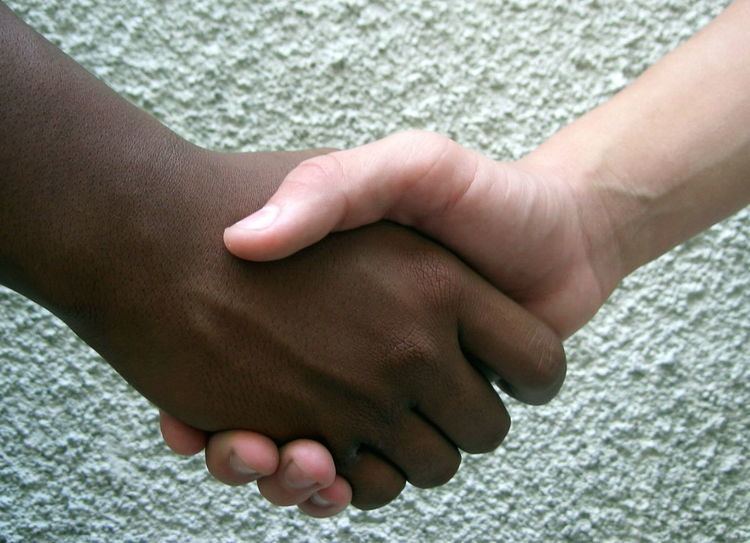 | ||
A handshake is a short ritual in which two people grasp one of each other's like hands, in most cases accompanied by a brief up and down movement of the grasped hands.
Contents
Using the right hand is generally considered proper etiquette. Customs surrounding handshakes are specific to cultures. Different cultures may be more or less likely to shake hands, or there may be different customs about how or when to shake hands. Handshakes are known to spread germs.
History
Archaeological ruins and ancient texts show that handshaking – also known as dexiosis – was practiced in ancient Greece as far back as the 5th century BC; a depiction of two soldiers shaking hands can be found on part of a 5th-century BC funerary stele on display in the Pergamon Museum, Berlin (stele SK1708) and other funerary steles like the one of the 4th century BC which depicts Thraseas and his wife Euandria handshaking (see images on the right). The handshake is thought by some to have originated as a gesture of peace by demonstrating that the hand holds no weapon.
Contemporary customs
There are various customs surrounding handshakes, both generically and specific to certain cultures:
The handshake is commonly done upon meeting, greeting, parting, offering congratulations, expressing gratitude, or completing an agreement. In sports or other competitive activities, it is also done as a sign of good sportsmanship. Its purpose is to convey trust, respect, balance, and equality. If it is done to form an agreement, the agreement is not official until the hands are parted
Unless health issues or local customs dictate otherwise, usually a handshake is made with bare hands. However, it depends on the situation.
Germ spreading
Handshakes are known to spread a number of microbial pathogens. Certain diseases such as scabies spread the most through direct skin-to-skin contact. A medical study has found that fist bumps and high fives spread fewer germs than handshakes.
In light of the 2009 H1N1 pandemic, the dean of medicine at the University of Calgary, Tomas Feasby, suggested that the fist bump may be a "nice replacement of the handshake" in an effort to prevent transmission of the virus.
Chemosignaling
It has been discovered as a part of a research in the Weizmann Institute, that human handshakes serve as a means of transferring social chemical signals between the shakers. It appears that there is a tendency to bring the shaken hands to the vicinity of the nose and smell them. They may serve an evolutionary need to learn about the person whose hand was shaken, replacing a more overt sniffing behavior, as is common among animals and in certain human cultures (such as Tuvalu, Greenland or rural Mongolia, where a quick sniff is part of the traditional greeting ritual).
Records
Atlantic City, New Jersey Mayor Joseph Lazarow was recognized by the Guinness Book of World Records for a July 1977 publicity stunt, in which the mayor shook more than 11,000 hands in a single day, breaking the record previously held by President Theodore Roosevelt, who had set the record with 8,510 handshakes at a White House reception on 1 January 1907. This had already been broken, in 1963, by Lance Dowson in Wrexham, N.Wales who shook 12,500 individuals hands in 10 1/2 hours. This was recognised by the Guinness World Records Organisation and published in their 1964 publication. On the 31 August 1987 Stephen Potter from St Albans Round table shook 19,550 hands at the St Albans Carnival to take the World record for shaking most hands verified by the Guinness Book of records. The record has since been exceeded but has been retired from the book. Stephen Potter still holds the British and European record.
On Memorial Day 2008, two friends from Muscatine, Iowa, Kevin Whittaker and Cory Jens set the Guinness World Record for the world's longest handshake at 9 hours and 30 minutes in San Francisco, CA. On 21 September 2009, Jack Tsonis and Lindsay Morrison broke the Guinness World Record for the world's longest handshake, shaking hands for 12 hours, 34 minutes and 56 seconds. This record was broken less than a month later in Claremont, California, when John-Clark Levin and George Posner shook hands for 15 hours, 15 minutes, and 15 seconds. The next month, on 21 November, Matthew Rosen and Joe Ackerman surpassed this feat, with a new world record time of 15 hours, 30 minutes and 45 seconds certified in the latest edition of the Guinness Book of Records on page 111. At 8pm EST on Friday 14 January 2011 the latest attempt at the longest hand-shake commenced in New York Times Square and the existing record was smashed by semi-professional world record-breaker Alastair Galpin and Don Purdon from New Zealand and Nepalese brothers Rohit and Santosh Timilsina who agreed to share the new record after 33 hours and 3 minutes.
